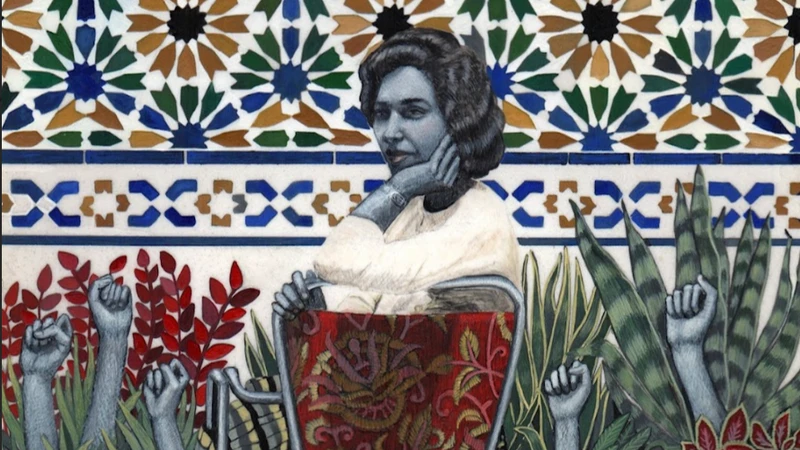Symposium: WOMEN, ART, FREEDOM
18 Nov 2023 10am-6pm


A day-conference of talks on the role of the arts in the movement for women's rights in Iran, with Keynote address by Professor Layla S. Diba on “The Warrior Women of Iran: A Forgotten History”
Organised by art historian Katayoun Shahandeh (SOAS) and sound artist Fari Bradley (UAL), this one- day symposium will bring together women academics and artists of Iranian origin to speak about the role of the visual and performing arts in the movement for women’s rights in Iran.
Supported by the University of Cambridge Centre for Gender Studies.
10:30 Registration + tea/coffee
11:00 SESSION 1
‘In the Time of Delirium’ Soheila Sokhanvari (Artist and Activist)
Women’s Agency and Resistance through Writing and Song in Iran Dr Evaleila Pesaran (Fellow and Lecturer in Politics and International Relations at Murray Edwards College, University of Cambridge)
Sonic Resistance within the woman, life, freedom movement in Iran Fari Bradley (Artist and Ph.D. Candidate, Centre for Research into Sound Arts Practice (CRiSAP), University of the Arts, London)
12:30 Lunch Break.
13:30 SESSION 2
"We women did not sink; we moved forward/ ما زنها فرو نرفتیم; پیش رفتیم" Dr Kristin Soraya Batmanghelichi (Associate Professor for the Study of Modern Iran at the University of Oslo and Faculty-at-Large at the Brooklyn Institute for Social Research in New York)
Photography in the Context of the Iranian Socio-Political Mitra Tabrizian (Artist and Filmmaker)
The act of freedom: the experience of Iranian actors inside the country and within the diaspora Isabella Nefar (Actor)
15:00 Tea/ Coffee
15:30 SESSION 3
Holding up the broken mirror: dissecting the challenges faced by Iranian diaspora theatre-makers in their representations of Woman, Life, Freedom Sepy Baghaei (Theatre Director)
Transmission as a tool of resistance: The case of Woman, Life, Freedom in the museums and universities of France Hanieh Delecroix (Artist and Writer)
Rising from the Ashes: The Semiotics of Subversion in the Works of Female Iranian Artists of the ‘Burnt Generation’ Katy Shahandeh (Artist and Ph.D. Candidate at Centre for Iranian Studies, School of Oriental and African Studies, London)
17:00 KEYNOTE ADRESS
The Warrior Women of Iran: A Forgotten History Dr Layla Diba (Art Historian and Curator)
18:00 DRINKS RECEPTION IN THE HEONG GALLERY
Keynote Address:
Dr Layla S. Diba is an independent art advisor, scholar, and curator specializing in the art of Iran in the 19th and 20th centuries. From 1975 to 1979, she was the founding director of the Negārestān Museum, Tehran, becoming the first woman to be a museum director in Iran. Dr Diba was curator of Islamic Art at the Brooklyn Museum, New York, and has been an advisor to several museums including the Metropolitan Museum of Art. Current projects include the publication of The Invention of the Modern Iranian Landscape: Mohamma Ghaffari Kamal al Molk’s Paintings of Mazanderan and Art in Peril: The Case of the Negarestan Museum and its Collections of 18 th and 19 th century Iranian Art. In 2023 she received the Ellis Island Medal of Honour.
The Warrior Women of Iran: A Forgotten History
Aspects of women’s political, social, religious, and literary lives have been explored in the scholarly literature on Iran, but only recently has the identity of the Iranian woman as rebel, warrior or guerilla fighter been recognized. Images of literary and historical heroines have been frequently visualized in Persian painting and will provide a rich source of imagery for our discussion. This stands in stark contrast with the virtual absence, silence and invisibility of women in public life.
This interest first appeared in pop culture and coincided with the historic women’s revolution in Iran in September 2022. I refer to the figure of the Amazon, previously associated with Ancient Greek History and Mythology and recently convincingly shown by reputed scholars to have lived in ancient times in areas of Western Asia and Iran.
Today I will reflect on this forgotten history and say the names of these Amazons. Women such as actual historical figures like the Achaeminid Queen Atossa and the 5th c BC admiral Artemisia; literary heroines of Ferdowsi’s Shah Nameh written in the eleventh century such as Gordafarid, the heroine of the 13th c tale of Warqa and Gulsha, the celebrated storyteller Shahrzad of the Thousand and One Nights and historical figures of the 19th century such as the Bahai poetess Tahereh Qorrat al Ain and the singer Qamar al Molk Vaziri. Closer to our own era, we will consider some of the heroines brought to life by Soheila Sokhanvari and their courageous descendants in the streets of Iran in the Fall of 2022.
This overview leads us to raise the question of the lack of women artists in Iran. We will consider the possible factors leading to their virtual absence until the dawn of the 20th century, as well as the significance of women as objects of the male gaze in pre-modern painting and in the practice of contemporary artists such as Shirin Neshat and Shadi Ghadirian.